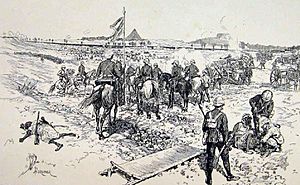Battle of Ginnis facts for kids
Quick facts for kids Battle of Ginnis |
|||||||
|---|---|---|---|---|---|---|---|
 Battle of Ginnis from The Illustrated London News |
|||||||
|
|||||||
| Belligerents | |||||||
| Commanders and leaders | |||||||
| Francis Grenfell | unknown | ||||||
| Strength | |||||||
| 3,500 | 6,000 | ||||||
| Casualties and losses | |||||||
| 10 killed & 41 wounded | 400 killed & many more wounded | ||||||
The Battle of Ginnis (also called the Battle of Gennis) was a small but important fight. It happened on December 30, 1885. British and Egyptian soldiers fought against warriors from the Mahdist State in Sudan.
The battle started because Mahdist fighters had surrounded the Ginnis-Kosha Fort. British commanders wanted to help the soldiers trapped inside. The British and Egyptian forces won the battle. This fight is special because it was likely the last time British soldiers wore their famous red coats in battle.
Contents
Why the Battle Happened
The Situation in Sudan
In 1884, a religious leader in Sudan named Muhammad Ahmad declared himself the Mahdi. This means he claimed to be a special leader chosen by God. His followers were called the Ansār. They attacked British and Egyptian forces. Thousands of Egyptian soldiers and a British general named William Hicks were killed.
Sudan was controlled by both British and Egyptian leaders. The British government decided to send General Charles Gordon to Sudan. He was supposed to help the Egyptian army and get people out of the city of Khartoum. But General Gordon decided to make Khartoum stronger instead. He prepared the city for a long siege.
The British government sent two groups of soldiers to rescue Gordon. But before they could reach him, Khartoum fell. General Gordon was killed. The British soldiers had to retreat, leaving behind several forts.
The Fort at Ginnis
One of these forts was near the towns of Kosha and Ginnis. British and Egyptian-Sudanese soldiers were stationed there. Thousands of Mahdist warriors began attacking the area. They surrounded the fort, trying to capture it.
General Evelyn Wood was the British commander in Egypt. He was also the leader of the Egyptian Army. He was worried about the fort and the attacks. So, he ordered Major General Francis Grenfell to clear the area of Mahdist fighters.
Grenfell's Army
General Grenfell gathered a strong force. He had two groups of infantry (foot soldiers) and one group of cavalry (horse soldiers).
His First Brigade included soldiers from the Royal Berkshires and the West Kent Regiment. It also had Egyptian artillery and engineers. This group was led by Brigadier General Butler.
The Second Brigade had soldiers from the Yorkshire Regiment and the Cameron Highlanders. It also included Sudanese and Egyptian soldiers. They had special mule-drawn cannons. Colonel Huyshe led this brigade.
The cavalry brigade was led by Colonel Blake. It had British and Egyptian mounted soldiers.
Some British soldiers wore their traditional scarlet red coats. But others, like the Durham Light Infantry, wore khaki uniforms. Egyptian soldiers wore white or khaki, and some officers wore blue coats. British soldiers wore white sun helmets. Egyptians wore red hats called fezes.
The Battle Begins
Early Morning Clashes
On December 30, 1885, at 5:00 AM, General Grenfell and his troops began to march. They moved from their camp, which was between the Ginnis-Kosha fort and another small fort.
The First Brigade marched at the front. The Camel Corps and Second Brigade followed behind them. The Second Brigade took positions near Kosha. The soldiers inside the fort saw their chance. They rushed out and attacked the town.
A steamboat called the Lotus was on the Nile River. It had a special machine gun. The Lotus reported that many Mahdist fighters were moving from Ginnis towards Grenfell's army. The Cameron Highlanders and Sudanese soldiers moved to stop them.
The Main Fight
As the Second Brigade fought through the palm trees near Ginnis, Mahdist riflemen fired at the First Brigade. Their shots were not very accurate. But the smoke from their guns hid Mahdist spearmen. These spearmen surprised the Camel Corps. The Camel Corps had to pull back. But the Durham Light Infantry moved forward and pushed the Mahdist attackers away.
The First Brigade then got ready to attack the main Mahdist camp near Ginnis. At the same time, the Second Brigade entered the town of Ginnis itself. They fought through the streets and took control of the town.
The First Brigade's attack forced the Mahdists to leave their camp. They retreated into a narrow pass called the Atab Defile. General Grenfell ordered Colonel Blake's cavalry to remove the Mahdists from this pass. The Mounted Infantry charged with bayonets and captured the Atab Defile.
A chase began, but Colonel Blake stopped his men. The Mahdists then ran away into the desert.
As the First Egyptian Battalion marched through Kosha, they found some Mahdists hiding in a house. These Mahdists still had their weapons. With a small cannon covering them, the Egyptians stormed the house. This was the last part of the battle.
After the Battle
The British and Egyptian victory at Ginnis was very important. It effectively ended the first part of the Mahdist War. This war had started in 1881.
After Ginnis, there were a few more smaller battles. But the main fighting ended when a large British and Egyptian army reconquered Sudan. This happened in a big campaign from 1896 to 1898. Most Mahdist resistance ended after the major Battle of Omdurman in 1898.

